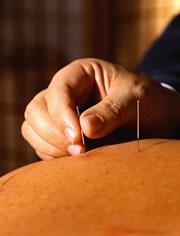 Tell me when it hurts: a mutation in a single gene can cause or inhibit pain.Punchstock
Tell me when it hurts: a mutation in a single gene can cause or inhibit pain.PunchstockImagine being unable to feel any pain at all. For a tiny handful of people, that is the reality — and medical researchers have now pinpointed the mutation that removes their ability to perceive painful sensations.
The study began when doctors in northern Pakistan examined a remarkable group of related families in which several individuals seem entirely unaffected by pain. Their attention was first attracted by one member of the clan, a locally famous boy who performed street theatre involving walking on burning coals and stabbing his arms with knives.
Although it sounds like a party trick, the condition is devastating, as sufferers don't learn to know their limits. The street-performing boy killed himself on his fourteenth birthday after jumping off a house roof. The researchers studied six of his relatives, aged between 4 and 14 years. All had suffered many cuts and bruises, and injuries to lips and tongue caused by biting themselves; several had fractured bones without noticing.
This shows the importance of pain for our health and survival, notes Geoffrey Woods of the Cambridge Institute for Medical Research, UK, who led the study. "Pain is there for a jolly good reason — it stops us damaging ourselves," he says. For example, the pain from a broken arm or sprained ankle encourages us to rest that body part while it recovers.
The children in the study had no such safety check, causing them to be both graceless and reckless. "One girl was continually knocked down in the playground and just didn't mind at all," Woods says.
Nerve condition
The researchers compared DNA samples from the six children and found that they all share a mutation in a gene called SCN9A, which is strongly expressed in nerve cells. They report their results in Nature1.
The SCN9A gene encodes a 'sodium channel': one of the structures that allows electrical charge to flow into nerve cells, triggering a signal, the researchers explain. Without this particular type of sodium channel, the brain does not receive any signal that the body has encountered a pain-causing stimulus.
The discovery answers the question of whether the Pakistani subjects are truly unable to perceive pain or simply indifferent to it. When the first ever pain-free patient was examined in the early twentieth century, some doctors thought that perhaps the condition involved a malfunction in the brain, rather than in the nerves.
The Pakistan patients did seem to understand the concept of pain, and had picked up a knowledge of situations in which other people experience it. While being observed in a game of soccer, some of the older children in the study even acted as if in pain after being tackled. "Often, if you don't look as if you feel pain people think you're odd," Woods says.
Oversensitive
Mutations in SCN9A are also involved at the other end of the pain spectrum, another recent study shows. Mutations that enhance, rather than inhibit, the protein's activation are at the root of paroxysmal extreme pain disorder, report researchers led by Mark Gardiner of University College London in the journal Neuron2.
ADVERTISEMENT
It therefore seems that SCN9A acts as a "major trigger" of pain, says Woods. "It's amazing that we missed it for so long and then out of the woodwork come these two disorders," he says.
This could offer potential new ways to treat severe pain. Current methods, such as local anaesthetics, are impractical, and constantly taking opiate painkillers can lead to addiction. Targeting SCN9A, perhaps through gene therapy, could also help sufferers of constant extreme pain from injuries, arthritis, spinal conditions or cancer.
But, as the Pakistani subjects showed, the new discovery is of no use in tackling that perennial human condition, emotional pain. "They can blush and cry, and when they have flu they feel unwell," he says. "And they are hurt by rejection just the same as anyone."
Visit our mutationthattakesaway_p.html">newsblog to read and post comments about this story.
